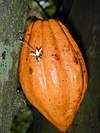White chocolate
White chocolate is a chocolate confection made from cocoa butter, sugar and milk solids. White chocolate does not contain cocoa solids, which are found in other types of chocolate.[1] It is characterized by a pale ivory color. The melting point of cocoa butter, the only cocoa bean component of white chocolate, is high enough to keep white chocolate solid at room temperature, as with milk chocolate and dark chocolate.
 Pieces of white chocolate | |
| Type | Chocolate |
|---|---|
| Course | Dessert |
| Place of origin | Switzerland |
| Main ingredients | Cocoa butter, sugar, milk solids |
Composition
White chocolate does not contain cocoa solids (the non-fat component of cocoa). Cocoa solids are the primary constituent of conventional chocolate liquor — chocolate in its raw, unsweetened form. During manufacturing, the dark-colored solids of the cocoa bean are separated from its fatty content, as with milk chocolate and dark chocolate. As a result, this cocoa butter is the only cocoa ingredient in white chocolate. Because it contains no cocoa solids, white chocolate contains only trace amounts of the stimulants theobromine and caffeine.[2] White chocolate may include additional flavorings, such as vanilla.[3]
Regulations
Regulations govern what may be marketed as "white chocolate": In the European Union, since 2000, white chocolate must be (by weight) at least 20% cocoa butter, 14% total milk solids, and 3.5% milk fat. [4] The same standards apply in the United States, since 2004, with the additional proviso that the product can include no more than 55% sugar or other sweeteners.[5] Before 2004, American firms were required to have temporary marketing permits to sell white chocolate.
History
In 1936, the white chocolate Galak was launched in Europe by the Swiss company, Nestlé.[6] From the 1940s to the 1990s, Nestlé produced a white chocolate bar with almond pieces called Alpine White that was marketed throughout the United States and Canada.[6] Hershey began mass production of white Kisses in the 1990s, a product that diversified during the early 21st century to include a chocolate white-dark swirl Kiss called the Hug.[6][7]
See also
References
- "White chocolate". Bon Appétit. 12 November 2007.
- Zoumas, Barry; Kreisler, Wesley; Martin, Robert (1980). "Theobromine and Caffeine Content of Chocolate Products". Journal of Food Science. 45: 314–316. doi:10.1111/j.1365-2621.1980.tb02603.x.
- Blumberg, Naomi. "Chocolate". Encyclopædia Britannica Online. Retrieved 28 July 2015.
- "Directive 2000/36/EC of the European Parliament and of the Council of 23 June 2000 relating to cocoa and chocolate products intended for human consumption". Retrieved 27 October 2010.
- "Title 21 Chapter I Subchapter B Part 163 of the Code of Federal Regulations". United States Government Publishing Office. 24 February 2017. Retrieved 27 February 2017.
- "The history Of white chocolate". The Nibble. The World’s Best White Chocolate. 1 April 2008. Retrieved 2 August 2013.
- Rachel Janik (14 February 2015). "How the Hershey's Kiss conquered Valentine's Day". Time. Retrieved 31 December 2019.
External links

